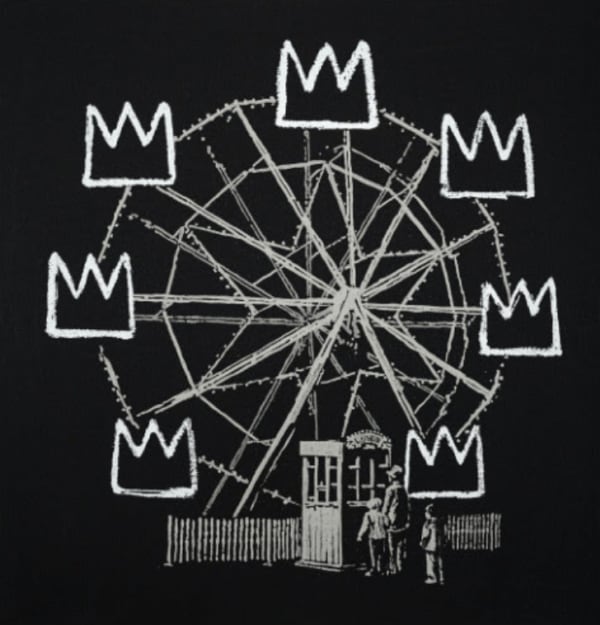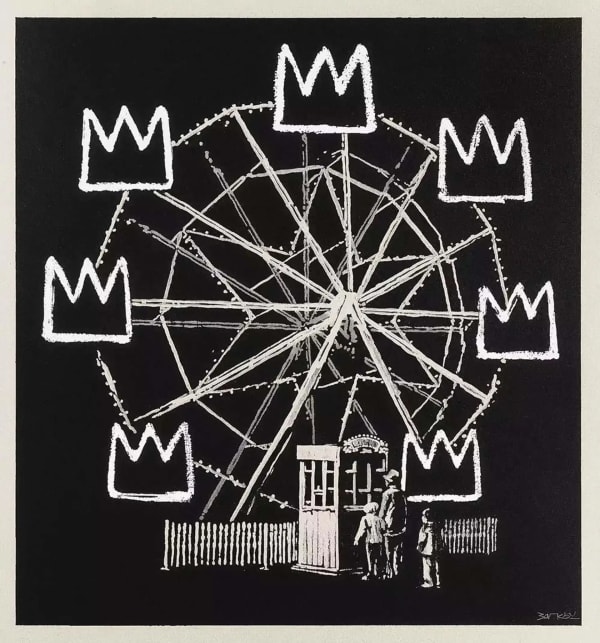-
Overview
"Art should comfort the disturbed and disturb the comfortable."
Banksy, the enigmatic and anonymous street artist, has captivated the world with his provocative and politically charged artwork. Emerging from the Bristol underground scene in the late 1990s, Banksy's works are now recognized globally for their distinctive stenciling technique and their bold commentary on contemporary social and political issues.
The elusive nature of Banksy's identity has only added to the allure and mystique surrounding his work. Banksy began his artistic journey in Bristol, England, as a graffiti artist. His early works, influenced by the Bristol underground scene, were characterized by freehand. However, as his style evolved, he adopted a stenciling technique which allowed for faster execution of his art, a crucial factor in evading law enforcement due to the illegal nature of graffiti. This method became his signature style, setting him apart in the street art community.
Banksy's art is often satirical, addressing topics such as war, capitalism, hypocrisy, and greed. His stenciled pieces, often combined with striking and witty text, have appeared on streets, walls, and bridges of cities across the world. His ability to convey powerful messages through visually simple yet impactful artwork has earned him a place among the most influential contemporary artists.
One of Banksy's most notable projects is the "Dismaland Bemusement Park," a temporary art project in the UK, which was a dystopian parody of an amusement park. Banksy has also been involved in various political and social campaigns, using his art as a tool for activism. His self-shredding artwork, "Girl with Balloon," which partially shredded itself after being auctioned at Sotheby's, made headlines worldwide, further cementing his status as a groundbreaking artist.
Despite his international fame, Banksy maintains an anonymous identity, which has led to widespread speculation and interest in who the artist might be. This mystery surrounding his identity has become a defining aspect of his persona and adds a layer of intrigue to his work.
Banksy's work continues to command high prices in the art market and attract widespread media attention. His art has sparked discussions and debates, transcending the traditional confines of the art world and engaging with a broader public audience. As a pioneer in street art, Banksy has had a significant impact on the genre, inspiring countless artists around the world.
In the world of contemporary art, Banksy remains a unique figure. His combination of art, mystery, and social commentary has made him an iconic figure in modern culture. His works, often provocative and always thought-provoking, challenge viewers to reconsider their surroundings and the socio-political landscape. As an artist, Banksy transcends mere visual expression, becoming a symbol of rebellion and a voice for social and political discourse.
-
Series
-
All
-
Choose Your Weapon
-
Di-Faced Tenner
-
Donuts
-
Flying Copper
-
Girl With Balloon
-
Grannies
-
Gross Domestic Product
-
Heavy Weaponry
-
I Fought the Law
-
Jack and Jill
-
Kate Moss
-
Laugh Now
-
Love is in the Air (Flower Thrower)
-
Morons
-
Napalm
-
No Ball Games
-
NOLA
-
Paintings
-
Prints
-
Pulp Fiction
-
Queen Victoria
-
Rats
-
Rude Copper
-
Tesco Soup Cans
-
Toxic Mary
-
Trolley Hunters
-
-
News
-

Banksy
About the Artist February 27, 2024Banksy , the pseudonymous street artist whose provocative and politically charged works have captivated audiences worldwide, operates within a complex web of revenue streams. From...Read more -

The Collection of Sir Elton John
Top Highlights of the Christie's Auction February 22, 2024The highly anticipated Christie's New York Auction of Sir Elton John's collection brings us into the iconic contemporary collection of a living music legend. From...Read more -

Investing in Banksy's Edition Canvas Works
A Strategic Art Market Insight February 16, 2024In the dynamic world of art investment, Banksy's edition canvas works stand out as particularly intriguing assets. Banksy, the pseudonymous England-based street artist, has become...Read more -

Banksy Prints
A Buyer's Guide January 24, 2024Collecting Banksy prints can be an exciting venture, blending the thrill of art collection with the intrigue and social commentary that Banksy's work is known...Read more -

Banksy Girl With Balloon
Banksy's Most Iconic Work January 14, 2024Read more -

2023 In Review
A Look Back December 29, 2023TO WRAP UP THE YEAR, WE ARE TAKING A LOOK BACK AT OUR TOP 10 BEST SELLING ARTISTS OF THE GALLERY. ANDY WARHOL WARHOL'S ART...Read more
-
-
Exhibitions













